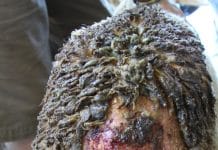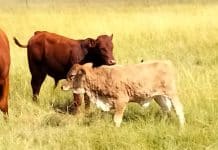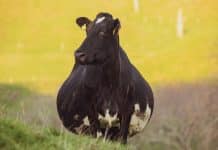Although the concept of terroir is usually associated with wine production, it is increasingly used to explain why meat produced in distinct regions has unique qualities that distinguishes it from other meat. The term terroir is therefore used to refer to a set of unique environmental factors that affect a crop, or in this case an animal or organism’s observable characteristics or traits. These observable traits are called phenotypes.
In South Africa, this concept is mostly applied to lamb meat and mutton, of which Karoo lamb is the most noteworthy. In 2016/17, Karoo Lamb received its official protected Geographical Indication (GI) status, which assures consumers that a product is really from the place name associated with it. This GI status is recognised by the European Union and is the only grading of its kind in South Africa. Europe, however, has a longer tradition of recognising meat from various areas as having unique sensory elements.
But what exactly are the different traits or characteristics of mutton and lamb meat produced in the various terroirs of South Africa? And which terroirs are associated with it? FarmBiz spoke to Dr Sara Erasmus, one of the researchers who helped prove that Karoo lamb does indeed taste different. We also look at some of the more noteworthy certified lamb and mutton found internationally.

The various terroirs
The fact that the plants growing in a specific region imparts unique sensory characteristics to the product produced in that region has been scientific proven. According to research done by Dr Erasmus and her then supervisors Prof Louw Hoffman and Nina Muller from Stellenbosch University, the diet of an animal has a direct effect on the flavour, aroma, texture and fat of its meat.
The diet is intrinsically linked to the typical vegetation of a region on which the animals graze. With the wide variety of biomes in South Africa, there is a noticeable variation in the sensory profiles of sheep meat.
The type of production systems in these regions also plays a role in sensory differences. Areas with extensive systems where animals mostly graze will thus differ from intensive systems where animals are rounded off in the feedlot, for example. According to the research done by Erasmus et al., South Africa has three main areas that deliver lamb meat and mutton with distinctive traits.
The most renowned region is the Karoo – a semi-arid area located in the Northern Cape that encompasses various biomes. The biomes are made up of fragrant indigenous plants (Karoo bushes) on which animals graze in extensive production systems. These natural pastures range from grassy, dwarf shrublands (Nama-Karoo biome) to dwarf, succulent shrubs (succulent Karoo biome), all imparting a herbaceous aroma and flavour to the meat produced in this region.
A less recognised region is that of the Rûens Shale Renosterveld, located in the Overberg and Rûens area in the Western Cape. The Overberg has a Mediterranean climate and sheep production is coordinated with winter grain cropping. The diet of sheep in this region consists of lucerne produced during the pasture phase. Small grain stubble can occasionally form part of the diet. Lamb produced here is known as Rûens lamb and due to the diet of lucerne, the meat is often described as oily or fatty.
The Free State grasslands region is well-known for its sheep production. This region consists of plains with summer rainfall and vegetation comprised mostly of Kimberley thornveld (savanna biome), and to a lesser extent that of the Western Free State clay grassland (grassland biome).
The sensory differences
As part of the research performed by Erasmus et al., a descriptive sensory analysis was done to determine which differences the sensory panel could detect. Care was taken to prepare the meat and fat using the same temperatures and cooking techniques. The panellists received training to fully understand which sensory attributes were in question. More details on the sensory descriptions used for this study can be seen in Figure 1.

The research found that the effect of diet on the fatty acid composition of ruminant meat is largely responsible for the variation in sensory profiles.
The transfer of some plant secondary metabolites, such as condensed tannins and terpenes, from forage to meat and fat was also studied. These are known as volatiles and are directly obtained from the diet, which influences the aroma and flavour of meat. By detecting the presence of volatiles in the meat, the diet on which the animal was reared can be determined and used as food tracers or markers of the geographical origin.
For example, pasture-fed lambs were found to have a sweet mutton flavour, while stall-fed lambs were associated with a lamb flavour. Grass-fed lambs had more flavours and aromas, usually associated with lamb liver, with less fatty flavours. Lamb meat from the Karoo, including the Central Karoo (CK), Northern Karoo (NK), Hantam Karoo/Loeriesfontein (HK/LO), and Knersvlakte (KV) was associated with herbaceous, savoury, spicy, and lamb-like flavours.
The meat was also considered to be more tender. Meat from the Hantam Karoo/Calvinia (HK/CAL) was associated with gamey, sheep wool and mutton-like attributes. In contrast, meat from Rûens and the Free State was regarded as oily with flavours and aromas described as barnyard/kraal, sheep wool, savoury/spicy and mutton-like. Meat from this region was found to be less tender.
A taste of Europe
In Europe, various types of sheep meat are protected through registration as either a Protected Designation of Origin (PDO) or Protected Geographical Indication (PGI).
Lamb of the salt meadows of Mont-Saint-Michel in France is a good example of one such type of meat. Unique sensory qualities are given to the meat due to the salt marshes the sheep graze on. Meat from this region is described as “pink to dark pink with a marbled appearance, juicy and produces intense, lasting flavours in the mouth, with no taste of wool grease” (Erasmus et al.).
There are several other lamb types recognised in the European Union (EU) that are reared on salt marshes and meadows. This includes Orkney lamb, Scotch lamb, and Shetland lamb. These lambs are finished and slaughtered on the Scottish mainland, including the islands off its coast (Orkney and Shetland). Intense flavour and tenderness are attributed to lambs reared here due to the extensive grazing on grassland. Shetland sheep also graze on seaweed and herbage.
Vadehavslam (Wadden Sea lamb) has a distinct salty taste due to grazing on the salty meadows in the Wadden Sea region of south-west Denmark.
Lamb from Aragon in Spain is a recognised type of sheep’s meat from the EU. Sheep are reared and slaughtered in the autonomous community of Aragon where they feed on mother’s milk (50 days minimum) supplemented with white straw and concentrates. The meat is light pink, tender, juicy, soft in texture, with small deposits of intramuscular fat that are attributed to their unique production system and diet. These are only a few examples of the unique sheep meat found in the EU. – Ursula Human, FarmBiz
For more information, contact Dr Sara Erasmus on sara.erasmus@wur.nl.








